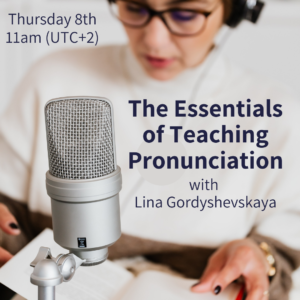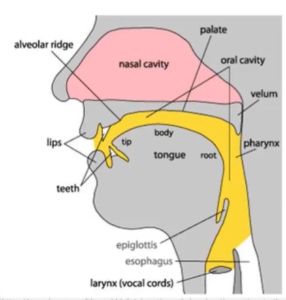It was fabulous to have Lina Gordyshevskaya join us to talk about the essentials of teaching pronunciation. Phonology is often seen during pre-service qualifications, with sessions tending to focus more on supra-segmental elements (connected speech, sentence stress, intonation, etc.). However, for a long time it has been seen as “the Cinderella of English teaching” (Adrian Underhill) as we focus more on grammar and vocabulary – though as we know, you can’t teach either of these without looking at pronunciation.
Teachers have a number of fears around pronunciation:
- fear of the chart (there was a suggestion to check out Mark Hancock’s version)
- where to start? what should I aim for? As we know, intelligibility is now the key, but many learners are still aiming to sound like a ‘native’ speaker – if that’s the case, dig deeper: why is this their goal?
- finding the balance between accuracy and intelligibility is important
Intelligibility is very tied to familiarity with accents as well: you may find it very easy to understand learners or other speakers in the context where you work, but struggle with accents from other areas.
Decoding is an important skill to help our learners with their receptive skills – rather than them being able to produce a model of connected speech phrases (e.g. /dʒə’wʌnə/), it helps them when they’re speaking to other people, watching shows or listening to English podcasts.
Depending on what your learners’ goals are, you can adjust your pronunciation work to suit their needs – who will learners be communicating with? Where will they be using English?
Also, it’s important to know your context and the issues your learners might have with English. There are some useful resources to help which can provide you with some generalized issues, but spending time with your learners and doing a needs analysis is the best way to gather information.
- Learner English, Swan and Smith
- How to teach pronunciation, Gerald Kelly
- Teaching the pronunciation of English as a Lingua Franca, Robin Walker
- Common mistakes by language background (online resource)
Generally, if you’re working in a monolingual context, your learners will have similar issues (although there may be times when a particular dialect within a language has features of English phonology which another doesn’t). However, with a multilingual class, you need to identify the most critical issues across each language and then find common issues as these will be the first you can focus on with the class together. When you focus on more specific issues, hopefully you’ll have the flexibility with your group to allow them to complete self-study rather than attending the class that day.
It’s important for there to be collaboration in setting the syllabus for pronunciation too – what you know learners need and what they would like.
Make it physical!
Make a start by getting learners familiar with what’s in their mouths and what’s involved in making sound. This can be as easy as the difference between voiced and unvoiced sounds, and then moving on to think about the place and manner of articulation of particular sounds so they can feel it.
Remember as well that we’re using muscles which need to be warmed up and as well that through practice, learners will become better able to produce the sounds more instinctively (muscle memory). There were some great analogies here around doing squats and yoga – you have to know how to do things well and then remembering how to do them to improve.
Make it visual!
Check out Tools for Clear Speech which has some incredible visuals.
You can use lots of other tools to make it more visual as well, such as rubber bands for identifying short and long vowels, hands, chopsticks, or paper to work with aspirated consonants.
Read Lina’s Top 10 resources for teaching pronunciation physically and visually
Make it practical!
Speech recognition is a great tool – it can be quite sensitive so learners need to exaggerate to pronounce the words quite clearly – apps on their phones, Google Docs, Google Translate.
You can also find examples of speech on sites such as Tube Quizard and YouGlish – this can be particular good for seeing how intonation changes in different phrases.
Series are a great resource for learners to notice features of connected speech, or the difference in pronunciation of certain sounds in different accents. Although these aren’t always authentic (as scripted productions), you can sometimes find some more realistic shows and films, such as Chef, GoggleBox or talk shows.
Make it artistic!
Language is music with its own melody and rhythm.
Often with pitch and intonation it can help to be a bit of a drama queen! Take a sentence and say it with different emotions to notice how your intonation changes. You can also try Lina’s activity Banana? Banana!
Working with intonation it can help to hear a sound at a different pitch; whilst working with rhythm and sentence stress can be done effectively with a metronome.
Intonation and pitch can be important in intelligibility as a phrase may sound sarcastic with a lower pitch or flat intonation or sympathetic with a falling intonation. Miscommunication or misunderstandings can occur if the intonation patterns of English – and other languages – aren’t familiar to your learners.
A couple of resources suggested in the comments were Carole Graham’s Jazz Chants and a book by Ken Wilson (which we couldn’t remember the name of) though you can find lots of scripts on his blog. Lina also mentioned the short film skwerl (How English sounds to non-English speakers) – have students listen first without watching and try to guess what’s happening between the two people…usually they’re able to identify the plot from the way the actors are speaking, even though they’re not using coherent English.
Extras
What’s your approach to phonology? Is it integrated into your lessons or a stand-alone slot?
Be proactive – analyse what you’ll be working with to predict what problems might arise with pronunciation.
Teach your learners communication strategies so they know what to do if there’s a communication breakdown due to pronunciation.
There was also some chat around ELF / EIL – thanks to Lucy for this definition in the chatbox:
“E.I.L.: English as an international language, a newer acronym which implies English is going to be spoken in almost all situations where a second language is required. E.L.F.: English as lingua franca, which is similar to E.I.L. but implies a situation where two people who need to communicate are forced to use English.”
Communication is about collaboration – the listener needs to be willing to understand the speaker as much as the speaker needs to be intelligible There was an interesting post on Robin Walker’s English Global Communication blog with research that suggested intelligibility in the past was often judged by inner circle speakers.
As teachers, we can do a lot to dispel the ‘native speaker ideal’ by introducing our learners to different accents from around the world – both models of speakers whose first language is English, as well as role models of people who have learnt English themselves as a second (or third, fourth, fifth) language!
L1 can be useful to show similar sounds – even in multilingual classes, learners can try to identify a sound which is similar in their own language.
Sometimes as well it can help learners to make one sound to move to another, such as /w/ to /r/.


1 thought on “The Essentials of Teaching Pronunciation”